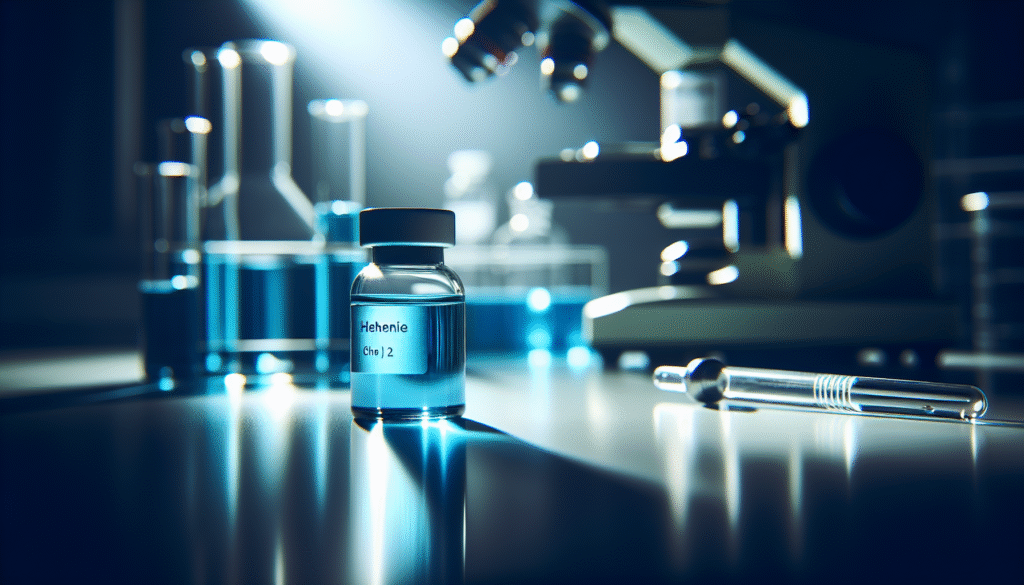
What do you know about Methylene Blue? Is it merely a laboratory dye to you or could it be something more significant?

Introduction to Methylene Blue
Methylene Blue is more than just a bright blue dye; it has a rich history and various applications that extend far beyond mere aesthetics. This compound, known scientifically as thionine or methylthioninium chloride, has garnered attention not only in the field of chemistry but also in medicine, biology, and even psychology. Understanding its properties and potential uses can provide valuable insights into its role in various disciplines.
The Chemical Structure of Methylene Blue
To appreciate Methylene Blue, you should first understand its chemical structure. Composed of a phenothiazine skeleton, Methylene Blue features a sulfur atom and four nitrogen atoms within its interconnected rings. With a molecular formula of C16H18ClN3S, it easily dissolves in water, allowing for various applications.
Properties of Methylene Blue
Methylene Blue is known for its deep blue color, UV-Vis absorption characteristics, and redox properties. Its solubility in water is particularly noteworthy, as this aspect enhances its utility in both laboratory settings and clinical applications. In essence, the properties of this compound make it versatile and inherently valuable.
| Property | Description |
|---|---|
| Molecular Formula | C16H18ClN3S |
| Solubility | Soluble in water; slightly soluble in alcohol |
| Color | Deep blue |
| Primary Usage | Stain for biological specimens; therapeutic agent in medical applications |
Historical Background
Understanding the historical context of Methylene Blue enhances your grasp of its significance. This compound was first synthesized in 1876 by the German chemist Heinrich Caro and initially used as a dye in textiles. Over time, researchers discovered it had valuable properties in medical and biological contexts.
Methylene Blue in Medicine
In medicine, Methylene Blue gained prominence early in the 20th century. Physicians utilized it primarily to treat conditions like methemoglobinemia, a condition characterized by the presence of oxidized hemoglobin, which diminishes oxygen delivery. Its capability to act as a reducing agent makes it effective in restoring the hemoglobin’s oxygen-carrying capacity.
Expansion of Applications
As research progressed, the applications of Methylene Blue expanded further. It began appearing in studies related to other medical conditions, ranging from Alzheimer’s disease to various types of infections. Its properties sparked curiosity regarding its potential therapeutic effects, making it a subject of ongoing scientific inquiry.
Methylene Blue in Medicine
You may wonder how Methylene Blue functions as a therapeutic agent. Its mechanism of action is multifaceted, and understanding this aspect is crucial for comprehending its clinical relevance.
Mechanism of Action
When administered, Methylene Blue works by accepting electrons in the bloodstream, effectively converting methemoglobin back to hemoglobin, allowing the blood to transport oxygen more efficiently. It also exhibits antioxidant properties that can assist in mitigating oxidative stress related to various medical conditions.
Clinical Uses
The versatility of Methylene Blue extends to several clinical applications:
-
Methemoglobinemia Treatment: Most notably, it is used to treat methemoglobinemia. Depending on the severity of the condition, Methylene Blue may be administered intravenously to promote the reduction of methemoglobin levels.
-
Septic Shock: Some studies have suggested that Methylene Blue may play a role in managing septic shock due to its properties that improve vascular tone and blood flow.
-
Neurodegenerative Disorders: Preliminary research has posited that Methylene Blue may enhance cognitive function and slow the progression of neurodegenerative disorders like Alzheimer’s disease.
-
Antimicrobial Properties: Methylene Blue also exhibits antimicrobial activity, making it a candidate for the treatment of infections, especially those caused by resistant bacteria.
| Clinical Applications | Description |
|---|---|
| Methemoglobinemia | Restores hemoglobin functionality |
| Septic Shock | Improves vascular tone and blood flow |
| Neurodegenerative Disorders | Potential cognitive enhancer |
| Antimicrobial Activity | Effective against resistant bacteria |

Methylene Blue in Research
Researchers have begun to explore Methylene Blue as a multifaceted tool in various scientific investigations. Its diverse properties have made it a subject of renewed interest in biomedical research.
Role in Biological Stains
One of the most established uses of Methylene Blue in research is as a biological stain. Its ability to penetrate cellular membranes and interact with nucleic acids makes it particularly useful in microscopy. Researchers commonly employ it for staining bacteria, cells, and tissues, facilitating the visualization of structures and processes.
Investigations in Psychiatry
Recent studies have advanced the discussion around Methylene Blue in psychiatry. For instance, its reported influence on mood and cognition has led researchers to examine its potential applications for treating depression or anxiety. Initial findings suggest that its neuroprotective properties may provide avenues for developing new treatments for mood disorders.
Antioxidant Research
An area of significant promise is the exploration of Methylene Blue as an antioxidant. Whether in the context of cellular aging or neuroprotection, Methylene Blue has shown potential to mitigate oxidative stress in various studies. Such research may eventually position it as a critical compound in preventive health strategies.
Safety and Side Effects
While Methylene Blue holds promise, its use is not without potential side effects and contraindications. You should be aware of these aspects if you are considering its use for any therapeutic purpose.
Common Side Effects
Some common side effects associated with Methylene Blue include:
- Nausea
- Vomiting
- Diarrhea
- Headaches
- Skin reactions
In most cases, these side effects are manageable, but they can present challenges for individuals who may be sensitive to the compound.
Contraindications
Methylene Blue may not be suitable for everyone. Individuals with hypersensitivity to thionine compounds, kidney disease, or those undergoing treatment with certain medications should exercise caution. Additionally, its use is contraindicated in patients taking selective serotonin reuptake inhibitors (SSRIs) due to the risk of serotonin syndrome.
Current Research Trends
Your awareness of ongoing research trends surrounding Methylene Blue can deepen your understanding of its evolving role in medicine and science.
Integration into Therapy
Current studies continue to investigate the integration of Methylene Blue into existing therapeutic regimens. For instance, its potential role in enhancing the efficacy of certain antibiotics is being explored.
New Formulations
Innovative formulations of Methylene Blue, particularly in nanotechnology, are attracting attention. Researchers aim to enhance its bioavailability and target delivery, allowing for increased effectiveness with potentially reduced side effects.
Methylene Blue in Cancer Research
Recent research has examined Methylene Blue’s potential in cancer treatment. Its ability to induce apoptosis in cancer cells is a particularly promising avenue of investigation. By understanding how Methylene Blue interacts with cancer cells, researchers hope to develop therapeutic strategies that incorporate this compound more effectively.
Practical Applications
Understanding how Methylene Blue can be effectively applied in practical settings can offer valuable insights for healthcare professionals and researchers alike.
Laboratory Use
In laboratory settings, Methylene Blue serves as an essential stain for studying microbiology and histology. Its ease of use and effectiveness make it a staple in these fields.
Therapeutic Administration
For healthcare providers, administering Methylene Blue requires careful consideration of dosage and patient history. While the compound shows promise in various therapeutic roles, it should be administered under appropriate clinical guidelines.
Patient Education
As a healthcare professional, educating patients about Methylene Blue’s uses, benefits, and potential risks is crucial. Providing balanced information can empower patients to make informed decisions regarding their treatment pathways.
Conclusion
Understanding Methylene Blue extends beyond its vivid hue; it encompasses its chemical structure, historical significance, medical applications, and ongoing research developments. As you reflect on this information, consider how Methylene Blue might play a role in your field, whether in medical practice, research, or education.
With ongoing advancements and a wealth of potential applications, Methylene Blue remains a key focus in various scientific disciplines. Staying informed about its properties, uses, and implications can only enhance the depth of your understanding and foster informed discussions around this fascinating compound.